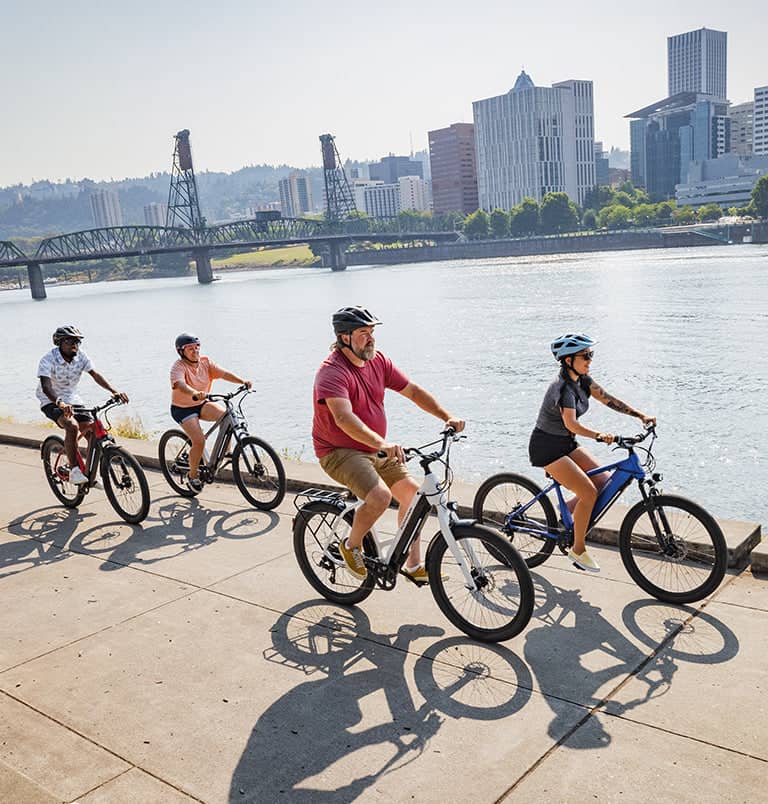Finding the right adult bike size is crucial for a comfortable and safe riding experience. Whether you’re a casual rider or a seasoned cyclist, the size of your bike can greatly impact your comfort, efficiency, and overall safety on the road.
In this article, we will explore why adult bike size matters and how to determine the right size for you. We will also discuss common adult bike sizes, adjusting your bike for a better fit, the importance of professional bike fitting, and conclude with the significance of finding the perfect adult bike size.
To find the perfect adult bike size, measure your inseam and match it with the appropriate frame size, ensuring a comfortable and efficient cycling experience.
Why adult bike size matters

Comfort
When it comes to cycling, comfort is key. Riding a bike that is too small or too large for your body can lead to discomfort and even pain. A bike that is too small may cause cramped leg and arm positions, while a bike that is too large can strain your muscles and joints. By choosing the right adult bike size, you can ensure a comfortable riding position that allows for proper posture and reduces the risk of strain or injury.
Efficiency
The size of your bike also affects your cycling efficiency. A bike that is properly sized for your body allows for optimal power transfer, enabling you to pedal more efficiently. When your bike fits you well, you can generate more power with each pedal stroke, making your rides more enjoyable and less tiring. On the other hand, an ill-fitting bike can lead to wasted energy and decreased performance.
Safety
Safety should always be a top priority when cycling. Riding a bike that is too big or too small can compromise your ability to control the bike effectively. A bike that is too small may result in a cramped riding position, making it difficult to maneuver and maintain balance. Conversely, a bike that is too large can make it challenging to reach the brakes and handlebars, potentially leading to accidents. By choosing the right adult bike size, you can enhance your safety on the road and reduce the risk of accidents.
How to determine the right adult bike size

Measure your inseam
One of the most important factors in determining the right adult bike size is your inseam measurement. To measure your inseam, stand barefoot with your feet shoulder-width apart and measure the distance from the floor to your crotch. This measurement will give you a good starting point for selecting the appropriate bike frame size.
Consider your riding style
Your riding style also plays a role in determining the right adult bike size. If you prefer a more aggressive riding position, you may opt for a smaller frame size.
On the other hand, if you prefer a more relaxed and upright riding position, a larger frame size may be more suitable. Consider your riding preferences and choose a bike size that aligns with your desired riding style.
Test ride different sizes
To ensure the perfect fit, it’s essential to test ride different bike sizes. Visit a local bike shop and try out bikes of various sizes to see which one feels the most comfortable and natural for you. Pay attention to how the bike handles, the reach to the handlebars, and the overall riding experience. Testing different sizes will help you determine the ideal adult bike size for your body and riding style.
Common adult bike sizes
Adult bike sizes can vary based on the type of bike (e.g., road bike, mountain bike) and the manufacturer. However, here’s a general overview of adult bike sizes based on frame height (in inches) and corresponding rider heights (in feet and inches):
| Frame Height (inches) | Rider Height (feet & inches) |
|---|---|
| 15 – 16 | 5’0″ – 5’4″ |
| 16 – 17 | 5’4″ – 5’7″ |
| 17 – 18 | 5’7″ – 5’10” |
| 18 – 19 | 5’10” – 6’1″ |
| 19 – 20 | 6’1″ – 6’4″ |
| 21 – 22 | 6’4″ – 6’6″ |

When it comes to adult bike sizes, there are several common options available. Here are some general guidelines for each size category:
Small (15-16 inches)
– Suitable for riders with an inseam measurement of around 27-29 inches.
– Ideal for individuals with a height range of 5’0″ to 5’4″.
– Offers a compact and maneuverable ride.
Medium (17-18 inches)
– Suitable for riders with an inseam measurement of around 30-32 inches.
– Ideal for individuals with a height range of 5’4″ to 5’8″.
– Provides a balanced combination of agility and stability.
Large (19-20 inches)
– Suitable for riders with an inseam measurement of around 33-35 inches.
– Ideal for individuals with a height range of 5’8″ to 6’0″.
– Offers a stable and comfortable ride for taller riders.
Extra Large (21+ inches)
– Suitable for riders with an inseam measurement of 36 inches or more.
– Ideal for individuals with a height range of 6’0″ and above.
– Provides an extended frame size for taller riders.
Remember that these size ranges are general guidelines, and individual body proportions may vary. It’s always best to test ride different sizes to find the perfect fit for your body.
Adjusting your bike for a better fit

Even with the right adult bike size, some adjustments may be necessary to achieve the best fit. Here are a few key areas to consider:
Saddle height
Adjusting your bike saddle to achieve a better fit is crucial for a comfortable and efficient cycling experience. Here are the steps to adjust saddle height for an optimal fit:
- Basic Height Adjustment:
- Start by sitting on the saddle with one pedal at the lowest position.
- Adjust the saddle height so that your leg is almost fully extended but not completely straight. There should be a slight bend in your knee.
- Checking the Height:
- When the pedal is at the lowest point and your heel is on the pedal, your leg should be fully extended. Adjust the saddle until you achieve this position.
- Pedal at 3 O’Clock Position:
- Sit on the bike and place one foot on a pedal in the 3 o’clock position (parallel to the ground).
- Your knee should be directly over the ball of your foot. Adjust the saddle height accordingly.
- Fine-Tuning:
- Test ride and make further adjustments as needed.
- If your hips rock side to side, the saddle is too high. Lower it slightly.
- If your knees feel strained at the bottom of the pedal stroke, the saddle may be too low.
- Record Your Settings:
- Take note of the saddle height that works best for you, so you can replicate it in the future or on other bikes.
- Recheck Periodically:
- Reevaluate the saddle height after a few rides to ensure it remains comfortable and effective.
Handlebar position
To adjust your bike for a better fit with handlebar position, follow these steps:
- Assess Your Current Position: Start by riding your bike and taking note of any discomfort or strain in your neck, back, or shoulders caused by the current handlebar position.
- Loosen the Stem Bolts: Using an appropriate tool, typically an Allen wrench, loosen the bolts on the stem that secure the handlebars to the fork.
- Adjust the Handlebar Height: You can raise or lower the handlebars by adjusting the stem height. Raise them for a more upright position and lower them for a more aerodynamic position. Make adjustments in small increments.
- Align the Handlebars: Ensure the handlebars are straight and aligned with the front wheel to maintain control and avoid any strain or discomfort.
- Check Your Comfort: Ride the bike again to assess the new handlebar position for comfort and functionality. If needed, make further adjustments until you find the right fit.
- Tighten the Bolts: Once you’re satisfied with the handlebar position, tighten the stem bolts securely to keep the handlebars in place.
- Fine-Tune as Needed: Ride the bike for a longer duration to confirm the adjustments and make any minor tweaks for optimal comfort and performance.
Stem length
Adjusting your bike’s stem length can significantly impact your riding comfort and efficiency. Here’s a brief guide on how to adjust stem length for a better fit:
- Understand Stem Length: Shorter stems provide a more upright and comfortable riding position, while longer stems promote a more aerodynamic and aggressive riding posture.
- Assess Comfort and Reach: If you experience discomfort or strain in your neck, back, or shoulders, you may need to adjust the stem length to achieve a comfortable reach while holding the handlebars.
- Loosen Stem Bolts: Use appropriate tools to loosen the bolts on the stem, allowing you to adjust the stem’s angle and length.
- Experiment with Length: If you want a shorter reach, consider replacing the stem with a shorter one. Conversely, if you need a longer reach, opt for a longer stem. Test different lengths to find what suits you best.
- Check Handlebar Height: Ensure the handlebars are at an appropriate height and angle for your riding style. Adjust the stem accordingly to achieve the desired height.
- Test Ride and Fine-Tune: After adjustments, go for a test ride. Pay attention to your comfort, handling, and overall riding experience. Fine-tune the stem length until you find the optimal fit.
- Consult a Professional: If you’re unsure about making the adjustments yourself, consider seeking assistance from a bike shop or a professional bike fitter for expert guidance.
Importance of professional bike fitting

While the guidelines mentioned above can help you find a suitable adult bike size, professional bike fitting can take your riding experience to the next level. A professional bike fitting involves a comprehensive assessment of your body proportions, flexibility, and riding style.
By analyzing these factors, a bike fitting specialist can recommend the perfect bike size and make precise adjustments to optimize your comfort, efficiency, and safety on the bike.
Conclusion

In conclusion, adult bike size plays a crucial role in ensuring comfort and safety while cycling. By choosing the right size, you can enhance your riding experience, improve efficiency, and reduce the risk of injuries.
Remember to measure your inseam, consider your riding style, and test ride different sizes to find the perfect fit. Additionally, make necessary adjustments to your bike and consider professional bike fitting for an optimal riding experience. So, take the time to find the right adult bike size, and enjoy your rides to the fullest.
FAQ
-
Is a 26-inch bike frame for adults?
Yes, a 26-inch bike frame is suitable for adults.
-
What size is an adult bike?
The size of an adult bike can vary, but it is typically between 26 and 29 inches.
-
Is a 24 inch bike for adults?
No, a 24-inch bike is generally more suitable for teenagers or shorter adults.
-
Is a 28 inch bike good for what height?
A 28-inch bike is suitable for taller adults, typically those with a height of 5’10” or above.
Originally posted 2023-06-07 10:41:10.

